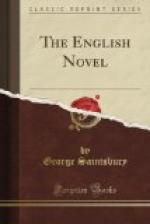For he has what no compiler as such can have—because the moment he has it he ceases to be a compiler, and becomes an artist—the sense of grasp, the power to put his finger, and to keep it, on the central pulse and nerve of the story. That he did this deliberately is so unlikely as to be practically impossible: that he did it is certain. The Arthurian Legend is the greatest of mediaeval creations as a subject—a “fable”—just as the Divina Commedia is the greatest of mediaeval “imitations” and works of art. And as such it is inevitable that it should carry with it the sense of the greatest medieval differences, Chivalry and Romance. The strong point of these differences is the way in which they combine the three great motives, as Dante isolates them, of Valour, Love, and Religion. The ancients never realised this combination at all; the moderns have merely struggled after it, or blasphemed it in fox-and-grapes fashion: the mediaevals had it—in theory at any rate. The Round Table stories, merely as such, illustrate Valour; the Graal stories, Religion; the passion of Lancelot and Guinevere with the minor instances, Love. All these have their [Greek: amarthia]—their tragic and tragedy-causing fault and flaw. The knight wastes his valour in idle bickerings; he forgets law in his love; and though there is no actual degradation of religion, he fails to live up to the ideal that he does not actually forswear. To throw the presentation—the mimesis—of all this into perfectly worthy form would probably have been too much for any single genius of that curious time (when genius was so widely spread and so little concentrated) except Dante himself, whose hand found other work to do. To colour and shape the various fragments of the mosaic was the work of scores. To put them together, if not in absolutely perfect yet in more than sufficient shape, was, so far as we know, the luck of Malory only: though some one (Map or another) had done a mighty day’s work long before in creating the figure and the adventures of Lancelot and imagining the later quest of the Graal with the figure of Galahad—that “improved Percivale,” as the seedsmen say.




